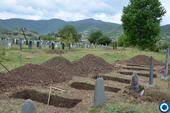Reports, opinions vary over border operation
By Salome Modebadze
Monday, September 3

A local resident of Pankisi gorge, a mountaneous region in Kakheti on the border with Chechnya, claimed that the 11 militants that were killed during the special operation carried out by Georgian military personnel were from Pankisi. “Today we are burying our youth,” the woman said on-air. Accusing President Mikheil Saakashvili of their death, she said that the Muslims will never pardon [Saakashvili].
The Information Centre of Kakheti (ICK) reported on August 31 that according to Idriz Numashvili, a resident of village Jokola, Georgian law enforcers threatened the local Kist people, saying that they will not be given the corpses of their children if they don't stop talking with the media.
The Guria News also reported that local residents of Pankisi gorge started digging six graves in the village of Duisi in a heavy rain late on Friday, to bury the dead according to their traditions, but the Guria News reported that no bodies were delivered to the families.
Zaal Kasrelishvili, Chairman of the Confederation of Peoples of the Caucasus said four of the dead guerillas were Kist from Pankisi gorge, one from Dagestan and one from Ingushetia. He said information about the rest is not yet known.
Georgian Dream coalition member Mamuka Areshidze, who is an analyst in Caucasus issues, said the Kist people respect the law and the state but they have their own traditions. “They are revolted by how the official version [of the military confrontation] differs from reality,” he told Maestro TV.
MIA spokesperson Salome Makharadze denied this information and stressed that none of the guerilla fighters were citizens of Georgia. She said several of them were the citizens of the Russian Federation and were from North Caucasus, while the information about the rest of the militants cannot been revealed until the investigation is completed.
But Deputy Minister Zurab Khizanishvili said that “the reaction of the Georgian state against any citizen that moves on the territory of Georgia with arms, kidnaps people, takes them as hostages, ignores the legal demands of police and kills officers of Interior and Defense Ministries, will be the same.”
Two MIA officers, a military doctor of the Ministry of Defense and 11 members of the armed group were killed at Lopota ravine located at the Georgian-Russian border. In addition, five officers were wounded while trying to detain the six foreign fighters during the operation on August 29.
Under the title “What really happened on the border with Dagestan in Georgia,” the Kavkaz Center reported that the military command of the CE Province of Dagestan concentrated a group of volunteer recruits in one of the mountain sections on the CE-Georgian border secretly both from Georgia and Russia “to an intended deployment site for further participation in the fighting against Russian occupation troops in the Province of Dagestan.”
However, the independent ChechenCentre reported that a Chechen presence in this battle was an impossibility, because according the Chechen authorities, no ChRI Forces crossed over to Dagestan.
Doubting that this battle carries more political character than military, the Chechen news agency said that “the only country that benefits from this “conflict” is Russia” because as the world watches Syria, President Vladimir Putin has the ability to “divide and conquer” the Caucasus.
